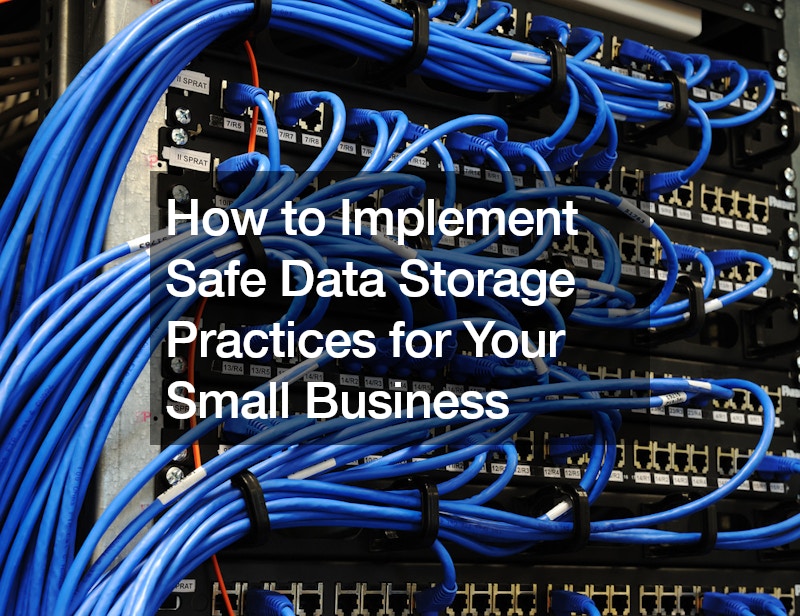In today’s digital age, data is one of the most valuable assets a small business can have. Protecting this data from loss, theft, or corruption is crucial for maintaining trust with customers and ensuring business continuity. Implementing safe data storage practices is not just a best practice but a necessity. Here’s a comprehensive guide on how to ensure your small business data remains secure.
Assess Your Data Storage Needs
The first step in implementing safe data storage practices is to understand your specific data needs. What kind of data are you storing? How sensitive is it? How often is it accessed, and who needs access to it? By answering these questions, you can tailor your data storage strategy to fit your business requirements. This assessment will help you decide between different storage options, such as local storage, cloud storage, or a hybrid approach.
Choose the Right Storage Solution
Selecting the appropriate storage solution is critical. Here are a few options to consider:
Local Storage: Storing data on physical devices like hard drives and servers located within your business premises. This option offers quick access and control but requires robust security measures to protect against physical theft and damage.
Cloud Storage: Utilizing third-party services to store data off-site. Cloud storage provides flexibility, scalability, and often includes built-in security features. However, it requires a reliable internet connection and trust in the service provider.
Hybrid Storage: Combining local and cloud storage to leverage the benefits of both. Critical or frequently accessed data can be stored locally, while backups and less sensitive information can be kept in the cloud.
Implement Strong Access Controls
Controlling who has access to your data is fundamental to safe data storage. Implement strong access controls by:
Assigning User Roles: Only allow access to data based on job roles and responsibilities. Use the principle of least privilege, granting the minimum level of access necessary for employees to perform their duties.
Multi-Factor Authentication (MFA): Require multiple forms of verification before granting access to sensitive data. MFA significantly reduces the risk of unauthorized access.
Regular Audits: Conduct regular audits of access logs to monitor who is accessing what data and when. This helps in identifying any unauthorized access or suspicious activity.
Encrypt Your Data
Encryption is one of the most effective ways to protect your data. By converting your data into a code that can only be deciphered with a key, you make it unreadable to unauthorized users. Ensure that both data at rest (stored data) and data in transit (data being transmitted) are encrypted. Many storage solutions offer built-in encryption features, so take advantage of these capabilities.
Regular Data Backups
Regularly backing up your data is crucial for recovery in case of data loss due to hardware failure, cyber-attacks, or natural disasters. Implement a comprehensive backup strategy that includes:
Frequency: Determine how often backups should be performed based on the frequency of data changes. Daily or weekly backups are common practices.
Redundancy: Store backups in multiple locations, such as local devices, cloud storage, and off-site physical locations. This ensures that a single point of failure does not lead to complete data loss.
Testing: Regularly test your backup and recovery process to ensure that data can be restored quickly and completely.
Educate Your Employees
Human error is one of the leading causes of data breaches. Educate your employees about safe data storage practices, including:
Recognizing Phishing Attempts: Train employees to identify and report phishing emails and suspicious links.
Strong Password Practices: Encourage the use of strong, unique passwords and change them regularly.
Data Handling Procedures: Establish clear guidelines for handling and sharing data securely.
Keep Software Updated
Regularly updating your software is vital for maintaining data security. Software updates often include patches for security vulnerabilities that could be exploited by cybercriminals. Ensure that your operating systems, applications, and security software are always up-to-date.
Implement a Disaster Recovery Plan
A well-thought-out disaster recovery plan is essential for safe data storage. This plan should outline the steps to take in the event of data loss or a security breach, including:
Response Procedures: Define the immediate actions to be taken following an incident to mitigate damage.
Communication Plan: Establish clear communication protocols to inform employees, customers, and stakeholders about the incident and recovery efforts.
Recovery Objectives: Set recovery time objectives (RTO) and recovery point objectives (RPO) to determine limits for data loss and acceptable downtime.
Utilize Professional Services
If managing data security seems overwhelming, consider hiring professional services. Managed IT service providers can offer expertise in implementing and maintaining safe data storage practices. They can also provide ongoing monitoring and support to ensure your data remains secure.
In conclusion, implementing safe data storage practices for your small business is essential to protect your valuable data and maintain operational integrity. By assessing your needs, choosing the right storage solution, enforcing strong access controls, encrypting data, performing regular backups, educating employees, keeping software updated, having a disaster recovery plan, and leveraging professional services, you can significantly enhance the security of your business data. Prioritizing these practices will help safeguard your business against data loss and cyber threats.
.





